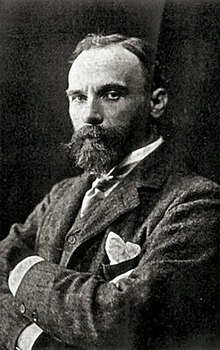John William Waterhouse
John William Waterhouse | |
|---|---|
 Waterhouse, circa 1886. | |
| Born | 6 April 1849 |
| Died | 10 February 1917 (aged 67) |
| Nationality | British |
| Education | Royal Academy |
| Known for | Painter |
| Notable work | Hylas and the Nymphs The Lady of Shalott Ophelia |
| Movement | Pre-Raphaelite |
John William Waterhouse (6 April 1849 – 10 February 1917) was an English painter in the Pre-Raphaelite style. He worked after the breakup of the Pre-Raphaelite Brotherhood, and so was called "the modern Pre-Raphaelite".[1] He was also influenced by his contemporaries, the Impressionists.[1] His artworks were known for their depictions of women from both ancient Greek mythology and Arthurian legend.
Born in Italy to English parents who were both painters, he later moved to London, where he enrolled in the Royal Academy of Art. He soon began exhibiting at their annual summer exhibitions, focusing on the creation of large canvas works depicting scenes from the daily life and mythology of ancient Greece. Later on in his career he came to embrace the Pre-Raphaelite style of painting despite the fact that it had gone out of fashion in the British art scene several decades before.
Although not as well known as earlier Pre-Raphaelite artists such as Dante Rossetti, John Millais and William Holman Hunt, Waterhouse's work is currently displayed at several major British art galleries, and the Royal Academy of Art organised a major retrospective of his work in 2009.





